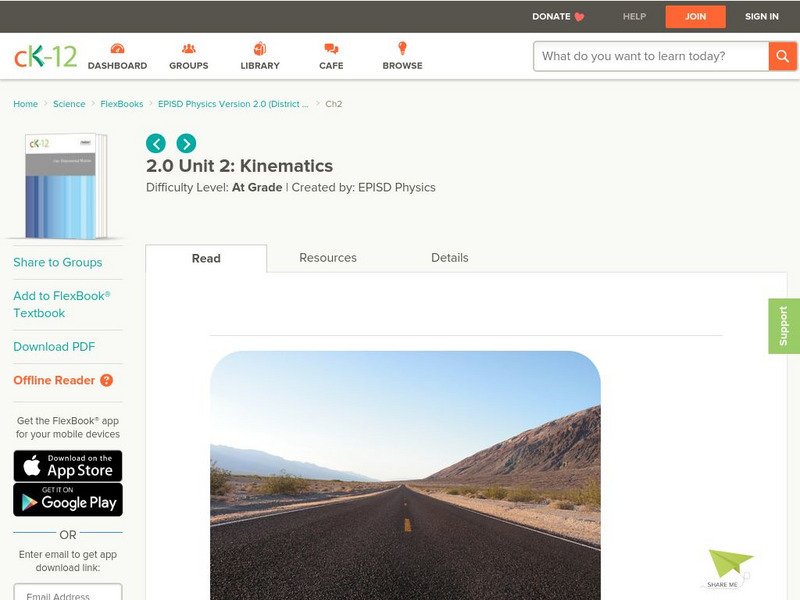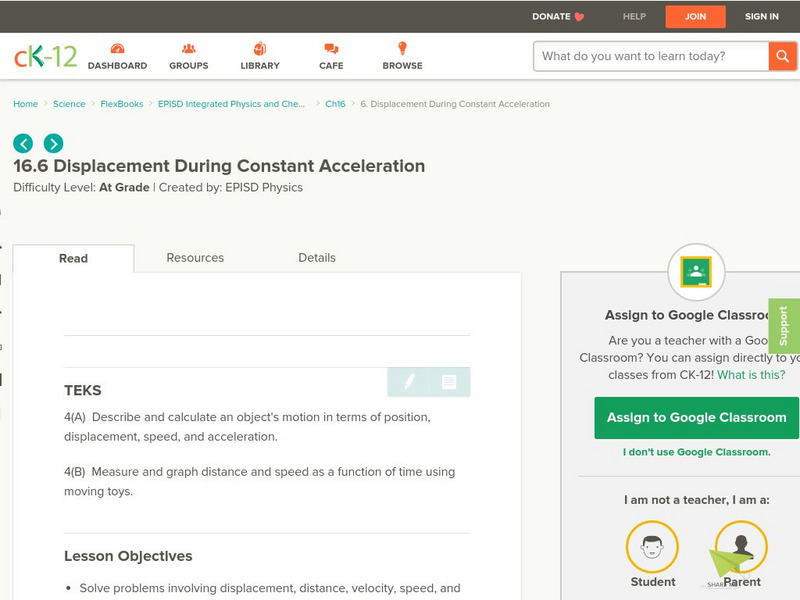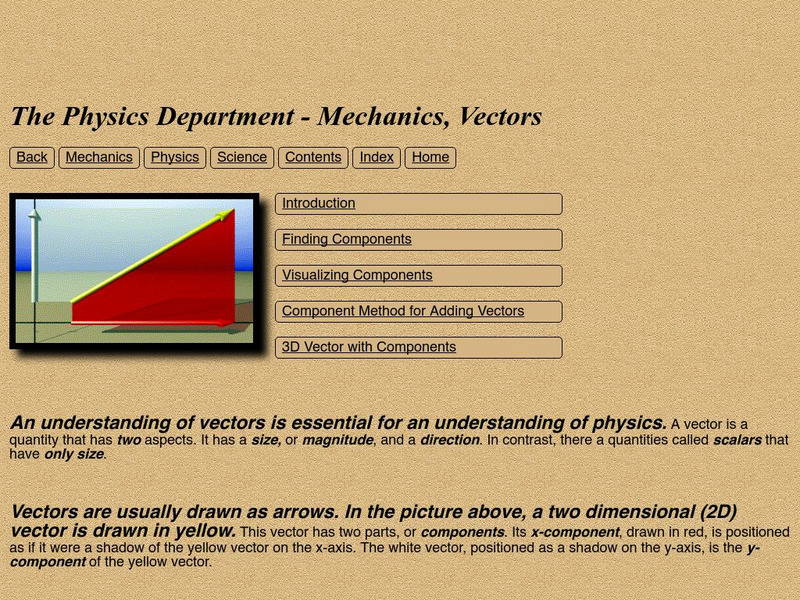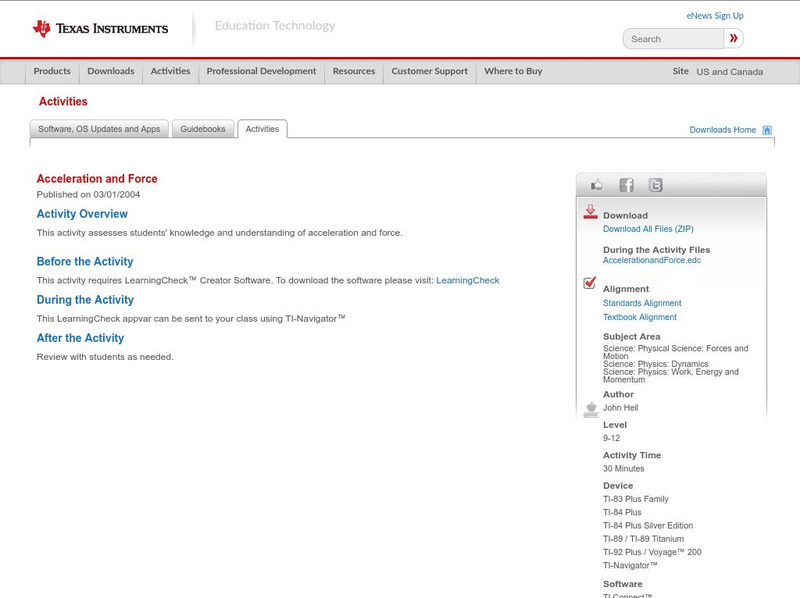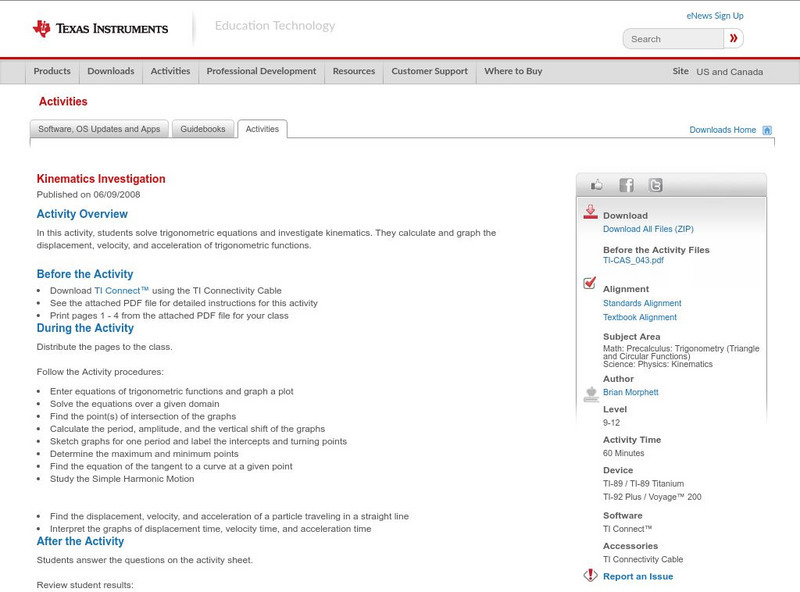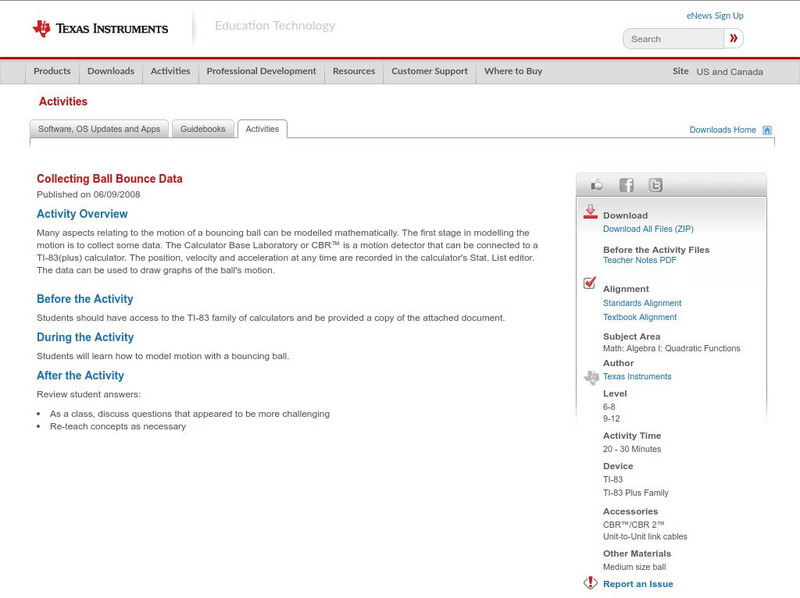CK-12 Foundation
Ck 12: Uniform Acceleration
[Free Registration/Login may be required to access all resource tools.] Students examine the difference between uniform acceleration and average acceleration, and preform calculations using uniform acceleration.
Science Education Resource Center at Carleton College
Serc: Student Analysis: Determine the Acceleration of a Toy Car
For this activity, students measure the displacement and elapsed time of a moving toy car using a direct measurement video with an embedded frame counter. They then calculate average and final velocity, and the average acceleration, and...
TED Talks
Ted: Ted Ed: The Math Behind Michael Jordan's Legendary Hang Time
Learn the affect of gravitational acceleration by calculating what Michael Jordan's hang time would be if he played basketball elsewhere in the universe.
CK-12 Foundation
Ck 12: Episd: Physics: Kinematics
[Free Registration/Login may be required to access all resource tools.] An online chapter focused on motion and the shapes it takes. Topics range from speed and velocity to acceleration and free fall. Find detailed visuals, learning...
CK-12 Foundation
Ck 12: Circular Motion
[Free Registration/Login may be required to access all resource tools.] In the following lesson students will be asked to analyze and describe accelerated motion in two dimensions using equations including circular examples.
CK-12 Foundation
Ck 12: Displacement During Constant Acceleration
[Free Registration/Login may be required to access all resource tools.] Students solve problems involving displacement, distance, velocity, speed, and acceleration, and then explore problems and graphs involving one-dimensional motion.
CK-12 Foundation
Ck 12: Physics: Motion Study Guide
This study guide on motion covers some key vocabulary and terms to describe motion: displacement vs. distance, acceleration, speed vs. velocity, and instantaneous vs. average. It includes graphs showing distance vs. time, velocity vs....
PBS
Pbs Learning Media: Newton's Triple Play: Baseball Science
In this lesson, students watch a video and animations that relate Isaac Newton's three laws of motion to baseball and apply what they've learned about these laws to another sport or other real-life situation.
Discovery Education
Discovery Education: 3 M Young Scientist Lab: Pie Pan Accelerometer
A metal pie pan demonstrates the acceleration of gravity.
Other
Bscs: Forces and Motion Content Background Document
In this document, we will try to answer a fundamental question of physical science, "Why do things start to move, slow down, speed up, stop moving or change direction?" In answering these core questions we can develop concepts that can...
Curated OER
Zona Land: Galileo and Inertia
A tutorial with accompanying animations on classical mechanics. Well-illustrated. Good navigation.
Curated OER
Zona Land: Components of a Vector
An interactive Java applet where users can rotate a vector about its tail and view the components of that vector. Magnitude of the components is updated on screen as the vector is dragged.
Curated OER
Zona Land: Mechanics and Vectors
An exceptional tutorial on the topic of vectors that offers many helpful graphics, some of which are interactive.
University of Utah
University of Utah: Dept. Of Mathematics: Physics of Skiing
Do you like to ski? If you do, do you ski for the physical sport of it? This resource turns the attention to the mathematical side of the winter sport.
Pennsylvania State University
Acoustics and Vibration Animations: Demonstrations: The Simple Pendulum
A series of graphics, downloadable animations and text describe and explain the motion of a pendulum. Some sections require an understanding of calculus.
Texas Instruments
Texas Instruments: Acceleration and Force
This activity assesses students' knowledge and understanding of acceleration and force.
Texas Instruments
Texas Instruments: Good Vibrations Activity Modeling Motion
The student will investigate Hooke's law and the position, velocity and acceleration of an object oscillating vertically on a spring.
Texas Instruments
Texas Instruments: Spring Thing
This activity uses the CBL, TI-83 Plus/TI-84 Plus, force probe, and motion detector to investigate the acceleration of a mass on a spring. It also investigates Hooke's Law.
Texas Instruments
Texas Instruments: Kinematics Investigation
In this activity, students solve trigonometric equations and investigate kinematics. They calculate and graph the displacement, velocity, and acceleration of trigonometric functions.
Texas Instruments
Texas Instruments: Numb3 Rs: Up to Speed
Based off of the hit television show NUMB3RS, this lesson builds upon the familiar d=rt formula for distance to include elements of acceleration as well. The lesson is framed in the context of traffic flow theory, but makes some very...
Texas Instruments
Texas Instruments: Collecting Ball Bounce Data
Many aspects relating to the motion of a bouncing ball can be modelled mathematically. The first stage in modelling the motion is to collect some data. The Calculator Base Laboratory or CBR is a motion detector that can be connected to a...
Texas Instruments
Texas Instruments: Acceleration Due to Gravity
Students will collect data of different massed cars and compare the acceleration down an incline.
Texas Instruments
Texas Instruments: How Can a Clock Part Measure Gravity?
In this activity students will learn how to make a simple pendulum. Students' will use a motion detector to measure the period of a pendulum and calculate its acceleration.They will also understand the effect that gravity has on the...
Texas Instruments
Texas Instruments: Good Vibrations
In this activity, students will investigate the motion of a mass moving up and down on a spring. They collect data for the position, velocity, and acceleration of the mass's motion and examine the relationship between them.





